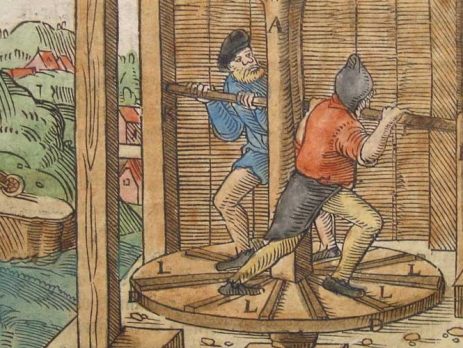Brief history of mining and prospecting in Horní Město until 1945
Horní Město and its wider surroundings are known as an extensive mining area, where mining was already carried out in the Middle Ages. The center of this area was Rýmařov, later Jeseník (formerly Frývaldov). The oldest known documentary evidence of mining dates from 1346 – 1360. However, the beginning of mining can be dated back to the 12th century, when primary deposits of silver-bearing galena were traced. Constant changes lead to frequent closures and renewals of mining in this area. At the beginning of the 16th century, mining recorded a strong rise. With the further expansion of mining, Ferdinand I permits in 1534 in Rýmař’s mint and elevates the mine (Bohaté štice) to a free royal mining town with the seat of the mining court Bergstadt-Hangenstein (Upper Town – Rocks), later Bergstadt. A major boom in mining occurs in the years 1490 – 1510, when the richest lots of silver-bearing galena are extracted, then decline occurs. Meanwhile, however, iron mining is on the rise. At the beginning of the 18th century there is another attempt to resume mining in 1703, when the Antonín Paduánský adit is opened in Horní Město.
Mining takes place in short stages. At this time, the ore has a content of 37 g/t Ag and ore 950 g/t Pb (according to documents of the Royal Mint).
The great boom in silver mining in the 15th and 16th centuries is conditioned by the fact that ores were extracted from rich subsurface ore lots. A sudden drop in metallurgy and an increase in production costs are the main reasons for the cessation of mining operations at the end of the 16th century. In 1767 to 1768, the Antonín Paduánský mine was restored, work here began with the digging of over 600 m long hereditary tunnels. However, mining encounters an unfavorable and difficult loss-making process of ore extraction treatment. Compaction is also very expensive. Therefore, despite several attempts to continue mining, there is a decline again for a period of about 50 years. New attempts to restore the works began in 1833 on the initiative of the mayor of the Horní Město, F. Geitner, but they met with failure.
Further attempts in the years 1834-1840 and 1860-1870 also ended in failure. At the same time, however, iron ore mining is developing. A foundry near Karlovice and the first blast furnace in Rýmařov were opened in 1760, and at the same time new iron ore mines continued to be established.
All data and written reports show that the Horní Město – Skály area belongs to the oldest and most important mining centers in Jeseníky. Until the end of the 16th century, silver mining took place, and from the 17th century, with the decline of silver mines, the mining of iron ores developed. There is a boom in ironworks, built by Count Harrach, thanks to the temporarily prosperous iron ore mines in the vicinity of Horní Město and Rýmařov. Later, due to considerable costs under difficult conditions, with fluctuating powers and quality of ores, their decline and final extinction occurs. In 1880, mining was completely stopped.

